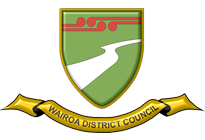Wairoa District
About the profile areas
The 2018 population for Wairoa District is 8,370, with a population density of 2.03 persons per square km.
Note: This page displays the area boundaries used for the 2018 Census. In some cases, these are significantly different to the pre-2018 areas. For more on this, see the Census 2018 page.
Location and boundaries
The Wairoa District Council area is located in the Hawkes Bay Region of the eastern coast of New Zealand's North Island, about 340 kilometres north-east of Wellington and about 340 kilometres south-east of Auckland. The Wairoa District Council area is bounded by the Whakatane District Council area in the north-west, the Gisborne District Council area in the north-east, the Pacific Ocean in the east, Hawke's Bay in the south, and the Hastings District Council area in the south-west.
Tangata whenua
The original inhabitants of the Wairoa area were the Ngati Kahungunu Māori people.
Name origin
Wairoa is named after the Wairoa River, which is named from a Māori word meaning 'long water'.
ImportantStatistics |
Population8,370 2018 Usual residents |
Land area4,130 square km |
Population density2.03 persons per square km |
Settlement history
European settlement dates from the late 1820s, with a whaling and trading station operating from the 1830s. Population was minimal until the 1850s when Wairoa developed a sea trade with nearby Napier in flax, fruit and timber, and land was leased for sheep and cattle grazing. During the 1860s the town rose to prominence, when it was a garrison town/military base. Growth took place during the late 1800s and early 1900s. The river port declined in the late 1930s when the railway was opened. Gradual growth from took place from the post-war years into the late 1960s. Gradual population decline occurred from the 1970s, with the population of the Council area falling from about 10,000 in 1996 to under 8,000 in 2013.
Land use
The Wairoa District Council area is predominantly rural, with a township at Wairoa and several smaller settlements. About half of the population live in the township of Wairoa, with the other half living in the rural areas and smaller settlements. Rural land is used largely for farming, particularly sheep grazing, with some cattle and dairy farming, fruit growing and forestry. The Council area encompasses a total land area of about 4,100 square kilometres, including over 100 kilometres of coastline.
Transport
The Council area is served by State Highway 2 and State Highway 38.
Major features
Major features of the Council area include Te Urewera National Park, the Wairoa, Mohaka and Nuhaka Rivers, the township of Wairoa, Lake Waikaremoana, Whakaki Lagoon, the Mahia Peninsula, Mangaone Caves, Morere Hot Springs, Morere Springs Scenic Reserve, Wairoa Museum, Blacks Beach, Mahanga Beach, Mahia Beach, Mokotahi Beach, Whakamahi Beach, Mahia Golf Club, Wairoa Golf Club and Wairoa Hospital and Health Centre.
Included areas
The Wairoa District Council area includes the townships and localities of Frasertown, Mahia, Maungataniwha, Nuhaka, Ruakituri-Morere, Raupunga, Tuai, Wairoa and Whakaki.
